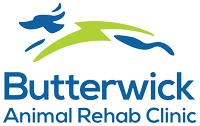One of the most common issues we see with dogs are cruciate ligament conditions, which can be caused by a number of things.
Age, exercise, weight… all of these can have an impact on your dog’s joints, in a similar manner to humans.
The problem is treatable, but, as with most things in life, prevention is better than cure, and there are a number of ways to prevent cruciate ligament injury in dogs.
What is the cruciate ligament?
As in humans, the cruciate ligament (actually, there are two) forms part of your dog’s knee. In dogs, the one that tends to suffer from the most regular damage is the cranial cruciate ligament (at the front of the knee). We can visualise these ligaments as like strong pieces of rope, connecting the femur (the bone at the top of the leg) to the tibia (the bone at the bottom of the leg) and allowing the knee joint to work as a hinge.
The ligament can worsen over time or it can suddenly rupture completely due to a dog knee injury.
Many owners are worried that they’ll miss the tell-tale signs, but if you know what to be alert for, it’s fairly easy to spot.
Dog cruciate ligament symptoms
While symptoms depend on the breed of dog and the severity of the injury, there are a number of common elements to look for…
- limping or lameness in either of the back legs
- stiffness in the back legs, especially when getting up or sitting down
- an unusual gait
- swelling over the knee joint
- unwillingness to exercise
Preventing cruciate ligament injuries
We often see a rise in the number of cruciate ligament injuries in the spring and summer, as dogs who have been indoors for a while, taken only on fairly brief walks, suddenly get used to a new lease of life.
Free to roam, perhaps off the lead, they try to run before they can walk (metaphorically speaking), without giving their joints time to acclimatise to the change in pace.
Therefore, one of the best ways to prevent such injuries is by maintaining a controlled exercise regime all year round. While exercise is obviously important (for some breeds more so than others), it is equally important to make sure your dog doesn’t overdo it and cause themselves any undue pain or trauma afterwards. Our experienced veterinary physiotherapists can help you develop a tailored exercise plan, whatever your dog’s needs or your lifestyle.
Other factors in preventing cruciate ligament injuries include weight management. Just like in humans, carrying excess weight can have a severe impact on joint health, putting a huge strain on them, so maintaining a healthy weight is vital for all sorts of reasons. Again, our team can help you develop a bespoke diet plan if your pooch is in danger of piling on the pounds.
If your dog has suffered a cruciate ligament injury in the past, they will be at high risk of going on to develop osteoarthritis. When the cruciate ligament is damaged, it can result in a change in the way the joint moves, damaging the meniscus – a cartilage which acts as a cushion inside the joint. You may want to consider joint supplements, which can help lubricate the joints and potentially slow down the process of this.
Treatment for a cruciate ligament injury
Should your dog have already suffered a cruciate ligament injury, your vet may prescribe anti-inflammatories and pain relief to help. They may also advise surgery but not necessarily in every case.
Combined with gentle physiotherapy in our expert rehab centre, such treatment can help your dog continue to live a long, happy and active life.
Another beneficial, drug-free treatment is hydrotherapy, which is extremely helpful in helping either manage or heal a cruciate ligament injury. At Butterwick, we have both a hydrotherapy pool and two underwater treadmills, offering soothing and healing benefits to your beloved pets.
The warmth of the water is soothing for aching joints and can help relax tight muscles, while the buoyancy provides support, making it easier for your dog to exercise and create normal movement patterns – a very important part of the rehabilitation process. The water also provides a hydrostatic pressure, so when your dog is submerged in the water this will help reduce swelling, allowing more movement in the joint and decrease pain.
For more information on any of our services, or for advice on all sorts of injuries, get in touch with our friendly and knowledgeable team – we can’t wait to meet you both!
